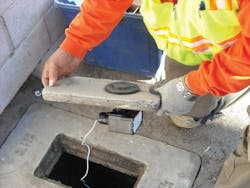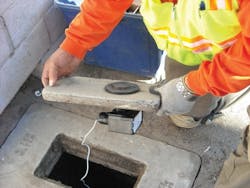Project Brings Hourly Water Data to California Utility
Editor's note: This article was adapted from a paper that will be presented at DistribuTech 2011, which will be held Feb. 1-3 in San Diego, CA.
By Lee Melville and Teri Kaczmarek
One million, two hundred thousand gallons. For an average hour on a peak water supply day, that's roughly how much water Burbank Water and Power (BWP) supplies to its customers. Knowledge of how this water is used has been increasing rapidly with the introduction of AMI to the utility's water operations.
With approximately 51,000 electric customers and 26,000 water customers, the utility's deployment of AMI meters is proceeding quickly throughout the service territory. For almost 100 years, BWP has been supplying electricity and water to the residents and businesses of Burbank, but only recently has management started to get a greatly improved image of the way in which their individual customers use this water and power.
AMI represents a step change in gathering the information to advance these initiatives. Moving from monthly reads to hourly reads enables a more granular view of the data, but is also akin to drinking from a fire hose.
By providing granular water consumption data BWP has empowered the consumer to become proactive in their water usage. Customers are able to identify and quantify their personal consumption patterns, verify compliance with conservation measures and minimize waste. BWP has also invested in a Meter Data Management System (MDMS) to support distribution and management of this new data, to ensure it is used to enable timely, smarter water usage decisions. This infrastructure will also allow BWP to offer new programs to customers to help save water, and remotely verify complaints or reports of violations to water conservation measures necessary at times when the environment demands restraint.
Hourly water data will also provide the ability to monitor leaks at many of their customer locations. The majority of residences will, at some point during the day or night, use little to no water for an hour or more. Leveraging AMI and MDMS technology will allow BWP to monitor this condition and alert customers to potential leaks as they occur to not only save water, but also save the shock of an increased bill when the leak continues undetected.
BWP selected Itron as the AMI provider for water metering operations. The AMI solution has the ability to gather time synchronized hourly reads from all meters within the city. Additionally, its offers the ability for future additions such as distribution leak detection for the city's distribution system. The fixed network solution consists of meter AMI endpoints, fixed network collectors, and network application software.
BWP leveraged the implementation of their Tropos Wireless Mesh network to provide communications between the field collectors and the utility's AMI server. In order to plan out the AMI deployment, BWP and Itron worked together to understand the endpoint geography and the corresponding communications coverage requirement.
Itron conducted a propagation study to determine ideal collector placement and thematically map the signal strength over BWP's territory. Exact placement of the collectors was designed to coincide with BWP property to avoid any extra work obtaining leases for installation on third party property. The deployment of collectors and endpoints was then allocated into two distinct project phases - the first for 2009/2010 and the second for 2010/2011. BWP made the decision to have its staff perform the installations to get familiar with the technology and retain knowledge of field conditions in-house at the utility. Currently, the average endpoint is read by approximately six collectors, exceeding the BWP requirements for network redundancy.
The retrofit process to install communication modules at BWP's water meters was complicated by the fact that BWP had a mixture of manually read and drive-by AMR water meters. BWP also wanted to incorporate their ongoing 15 year meter replacement cycle into the deployment. This equated to three different types of endpoint installation: traditionally read meters retrofitted with an Itron communication module (installation rate = 60-70 per day), traditionally read meters replaced with a new meter and communication module (installation rate = 15-20 per day), or an AMR meter whose communication module was replaced with an Itron version (installation rate = 100 per day).
The introduction of Itron technology provided a challenge for Neptune, the existing supplier of water meters to BWP. The Neptune E-Coder Registers were chosen for their high resolution (extreme low flow pickup), solid state (no moving parts) and easy to read digital LCD display. Neptune proved to be adaptive to BWP's needs and worked with Itron to ensure compatibility between their advanced meter register combo and the communication module.
As deployment progressed, BWP encountered communications challenges for certain endpoints in their network. Alleys and streets required non ferrous meter lid installations - BWP found high strength polymer lids that maintained structural needs and didn't impact signal strength. A very small percentage (less than 1% at various revolving locations) of the population would require field verifications due to alarm conditions. Steep canyons that make up a small segment of BWP's territory (less than 50 connections) were not conducive to AMI communications.
The alarm conditions normally require a field visit to correct the problem. Typical alarms are a result of environmental conditions, tampering, vandalism and communication issues.
Additional collectors might have been deployed to fully capture service points in rugged terrain, but this proved not cost effective so these situations were dealt with in a practical manner - BWP simply accepted that not all meters could be read via the AMI infrastructure and a manual reading solution would need to remain in place. BWP also maintained a philosophy that an infrequent walk-by visit to each location must be maintained to monitor infrastructure condition.
In parallel with the AMI deployment, BWP worked with Enspiria Solutions to select an MDMS vendor and support Meter Data Management System implementation with the associated business transformation. BWP selected Siemens Energy to implement the eMeter EnergyIP MDMS, with an initial focus on the meter to cash process.
The MDMS was configured to support an automated provisioning process whereby information for newly installed water endpoints are routed from CIS through the MDMS and on to Itron's SaveSource Application Server. This allowed for SaveSource to receive information regarding meters consistent with the other enterprise applications, plus it provided BWP with the ability to use the MDMS to monitor installed meter communications. The MDMS was fed daily read information from the Itron system. This then enabled the MDMS to submit the lists of successfully communicating water meters to CIS, so that the CIS was aware of which meters could be billed using MDMS data.
The functionality of the MDMS continued on past support for AMI deployment. BWP proceeded with billing via the MDMS as part of their initial implementation, which required some process changes. The traditional means for acquiring water reads for billing involved interaction between BWP's CIS, MV-RS meter reading software and field handhelds.
The challenge for the transition to MDMS was that the AMI deployment preceded the MDMS deployment somewhat, which called for an interim solution. Itron was able to provide this with a file exchange between the SaveSource Application Server and the MV-RS meter reading system. Essentially, the Application Server would submit AMI read data to MV-RS before the daily read list was generated from MV-RS to the meter reader's handhelds. This provided meter readers with only the non-AMI meters and prevented double work. Once the MDMS was moved into production, the water meter read information was submitted to the MDMS and CIS would then make the decision on whether to use MV-RS or MDMS for retrieval of billing determinants.
The recent completion of the meter to cash phase of the MDMS project marks the success of the AMI and MDMS implementation to date. A true measure of success is the improvements in customer experience already gained by the ability to more closely monitor water usage.
"We're able to detect unusual changes in the ways that our customers use water and investigate with the customer if we see a potential problem," said Kevin Mitchell, Water Maintenance and Construction Superintendent at BWP.
Mitchell related the story of one customer who demonstrated normal patterns of use - small consumptions at regular times, followed by times of inactivity. By using a basic data filter BWP was able to identify an increase in the minimum usage which never returned to zero.
Suspecting a leak, field service representatives visited the customer and showed the customer the fast spinning water meter. Upon further investigation, the customer found that some recent construction work at the premise had broken an underground pipe, and water was emptying into a catch basin at the rear of the property. The problem was quickly corrected, saving a significant amount of water and preventing a nasty shock with the customer's bill.
The data filter is a regularly scheduled manual process used to scrub the data to identify potential problems. Soon the process will be automated via the MDMS and one day will be available to the consumer.
As AMI deployment continues, BWP's use of the MDMS will help realize the AMI technology benefits with better automation for detection of leaks and a host of advanced reporting capabilities. The use of virtual metering will allow BWP to aggregate water consumption for groups of meters that belong to common points in the network. BWP will be capable of determining losses or consumption patterns for specific pressure zones, service types or geographic areas. The flexibility in billing offered by increased knowledge of customer water use will empower customers to be smarter about their consumption and take advantage of incentives to conserve and use efficiently.
About the Authors: Lee Melville is a project engineer with Enspiria Solutions Inc. His experience ranges from electrical substation automation to asset management systems including Advanced Metering Infrastructure (AMI), Meter Data Management Systems (MDMS) and Geographic Information System (GIS) technologies. Teri Kaczmarek is Manager Customer Service Operation for Burbank Water and Power since 1987 with over 22 years of experience in the utility business. She manages customer service which includes billing, meter reading, field operations, and the mail services. Along with her daily duties she is a full time project manager.
More WaterWorld Current Issue Articles
More WaterWorld Archives Issue Articles



